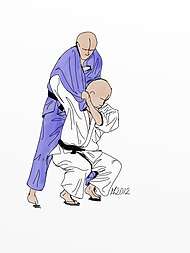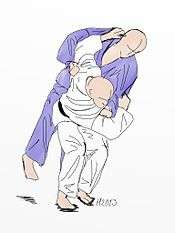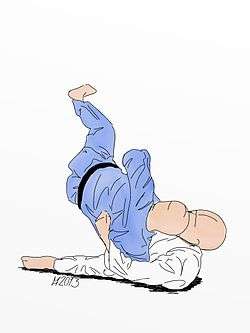Nage-no-kata
Nage-no-kata (Japanese: 投の形, "forms of throwing") is one of the two randori-no-kata (乱取りの形, free practice forms) of Kodokan Judo. It is intended as an illustration of the various concepts of nage-waza (投げ技, throwing techniques) that exist in judo, and is used both as a training method and as a demonstration of understanding.
| Nage-no-kata | |
|---|---|
 Tomoe nage, a rear sacrifice throw included in Nage-no-kata. | |
| Classification | Judo Kata |
| Sub classification | Randori-no-kata |
| Kodokan | Yes |
| Technique name | |
| Rōmaji | Nage-no-kata |
| Japanese | 投の形 |
| English | Forms of throwing |
History
The nage-no-kata was developed by Jigoro Kano as a method of illustrating principles of throwing to allow students to more effectively apply them in randori. Initially the kata consisted of ten techniques. These were subsequently appended with the addition of a further five throws, including kata guruma and uki otoshi.[1]
Description
The kata is composed of 3 techniques each from the five classifications of throw in judo:
- Te-waza (手技, hand techniques)
- Koshi-waza (腰技, hip techniques)
- Ashi-waza (足技, foot techniques)
- Ma-sutemi-waza (真捨身技, rear sacrifice techniques)
- Yoko-sutemi-waza (橫捨身技, side sacrifice techniques)
Each of these 15 techniques is performed twice in the specified order, both right and left handed. The kata is generally performed in a strictly formalised manner with clearly defined Reigi sahō (礼儀作法, rules of etiquette).
Aisatsu (挨拶, Salutation)
Tori (取り, the executor of the techniques in the kata) and Uke (受け, the receiver) approach the mat from opposite sides, with Tori on the left hand of the Joseki (上座, high point of the dojo) and Uke on the right (i.e. as they would be if facing towards the Joseki). They bow as they step on the mat, then turn to face the Joseki and execute a ritsu rei (立礼, standing bow), then turn to face each other and execute a zarei (座礼, kneeling bow). Tori and Uke step in, left foot first, to adopt shizen hontai (自然 本体, basic natural posture).
Te-waza (手技, hand techniques)

Tori approaches Uke using ayumi ashi (歩み足, walking gait). Tori and Uke grip using a standard right-handed sleeve-lapel grip. Uke initiates by stepping forward using tsugi ashi (次足, following gait) into migi shizentai (右自然态, right-handed natural stance). Tori responds by stepping backwards (tsugi ashi). Uke's balance is compromised and he attempts to regain the advantage by stepping forward again and Tori again responds by stepping backwards, further unbalancing Uke. On Uke's second attempt to regain his balance (i.e. his third step forward), Tori breaks rhythm, dropping to his left knee, and throws Uke to his rear, pulling with a steering motion.
Tori and Uke return to their feet and repeat the technique in the opposite (i.e. left-handed) orientation.

Uke approaches tori, steps forward with the right foot and raises the right hand as a hammer fist to strike directly on the top of tori's head. This works better if uke uses some power and momentum to strike. Tori allows the blow to begin to fall. Tori steps around 180 degrees, grabs (pulls) uke's right arm to continue to allow uke's momentum to follow forward (Tori does not deflect the blow!). The forward momentum of uke's blow makes uke fall onto tori's back (kuzushi). At the same time tori is ready to receive uke on his back and turns his shoulders and body while maintaining grip of the arm, redirecting the forward energy of the fall (and of uke) to the ground.
Tori and Uke return to their feet and repeat the technique in the opposite left-handed orientation.

Koshi-waza (hip techniques)



Ashi-waza (foot techniques)



Ma-sutemi-waza (rear sacrifice techniques)



Yoko-sutemi-waza (side sacrifice techniques)



References
- Kano, Jigoro (2008), "Kata Research", in Watson, Brian N. (ed.), Judo Memoirs of Jigoro Kano, Victoria, BC, Canada: Trafford, pp. 78–79
External links
- Judo Information Site. Nage no Kata instruction and links
- Nage No Kata Instructional Video
- A demonstration at the Kodokan. Tori: Dohba Yoshihisa Uke: Nishimoto Nimoru